In my last two reports (see one and two), the two brigades (Schotz’s Union brigade of 90 day volunteers, mostly from Wisconsin) had collided with Crutch’s brigade of mixed western CS units) in a meeting engagement at MacGillicuddy’s Corners somewhere on the Tennessee-Kentucky border in the early fall of 1861. This has been a solitaire game to help me learn the mechanics of Sam Mustafa’s Longstreet, and of course I had to also try out the campaign game rules. Since I’m pecking away at it a turn or so a night, it’s taking a while to tell the story.
Crutch’s rebs got the first volley in. The 21st Mississippi and Snedden’s battery pound the Schlitz Jaegers in front of them.
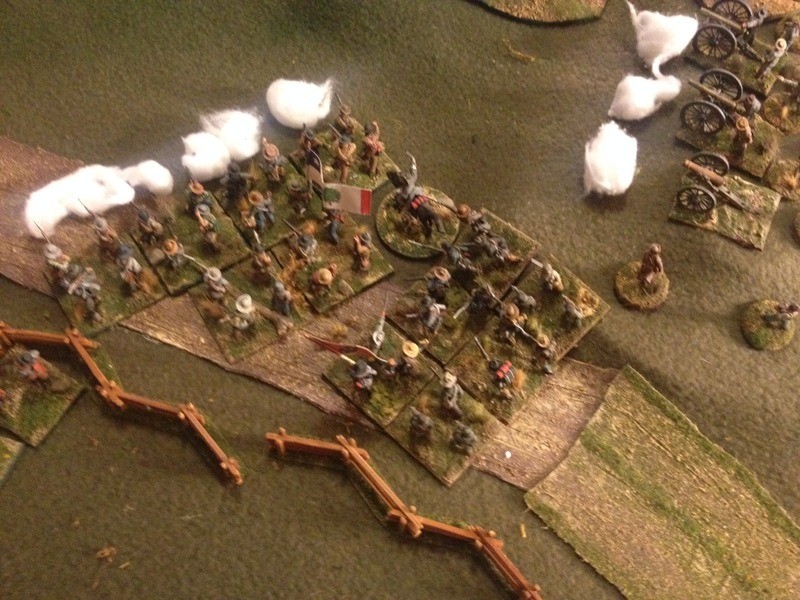
Confederate move phase is next. Union plays the Confusion Interrupt card which allows it to move one CS unit either forward or by the flank. Since the 19th TX (Galveston Rifles) were marching on the CS far right to extend the line, check the Union infantry on the other side of the hill and protect Snedden’s battery, the US uses the card to turn the head of the column to the right, into some woods and moving away from the Union. Perhaps the commander of the 4th saw a trail he liked? Some people might find this degree of friction excessively “gamey”. The Longstreet forums note that while it’s fun to play these interrupt cards, as more units get into action, it is far wiser to play cards to mitigate casualties rather than to generate grief for the opponent. At any rate, the 4th TX will need to get straightened out before it can move towards the US. Now that the Confusion card is played from the CS deck as an Interrupt card, it is removed from play for the rest of the game.
All other CS units remain stationary.
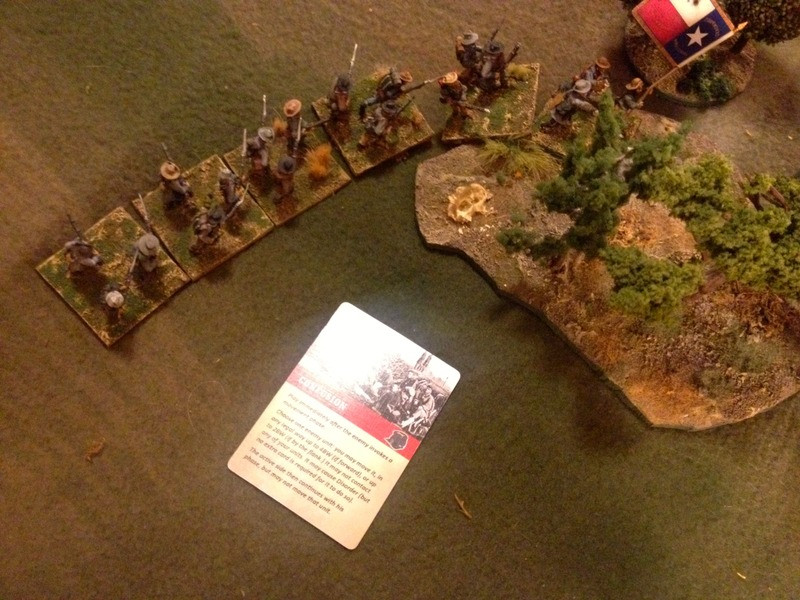
Union turn. US spends a card to declare a fire phase. The only unit that can shoot is the Schlitz Jaegers in the centre. They have four of six bases that can fire at up to a 45 degree angle and are within 6BW range of the 21st MS. They fire and after casualty mitigation, have one hit. Roll to kill (always a 4+ on a d6) is successful. One stand of the 21st MS is lost. First blood to the Union!
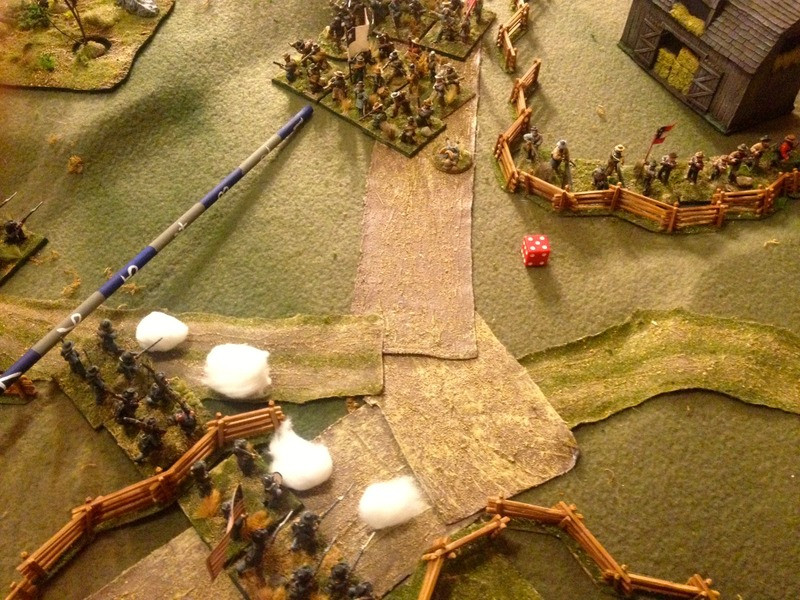
Union Movement Phase. It’s taken a while but Engel’s Brewer’s Battery (two 6lber smoothbores and one howitzer) has finally unlimbered and can fire next US turn. Is that a barrel of pilsner at far left?
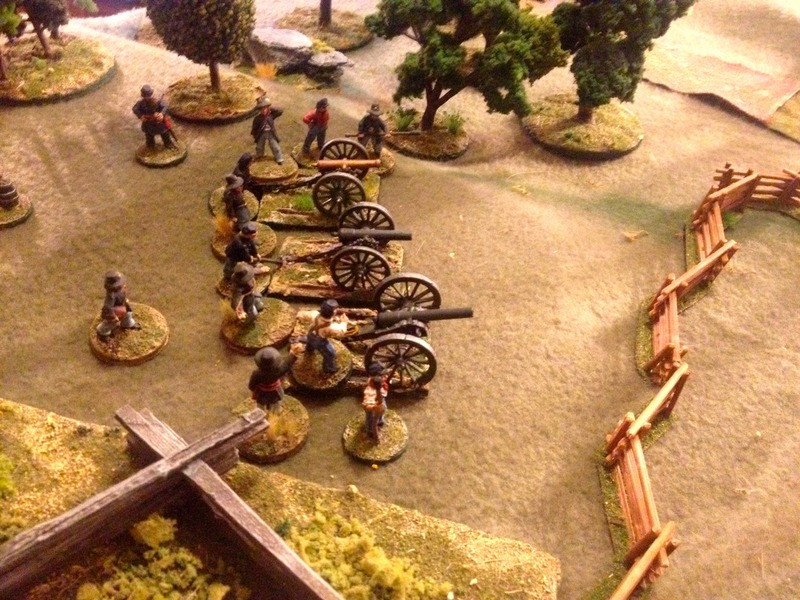
More US movement phase. Schotz make a virtue of necessity and has McCleary’s Milwaukee Irish (The Fightin’ Navvies) keep marching. Last turn you may recall the CS played a Confusion card and marched them off the road. Colonel Schotz is hoping to get reinforce his right and use the Irish and his cavalry to turn the CS flank, if he can get McCleary’s boyhos forward in time.
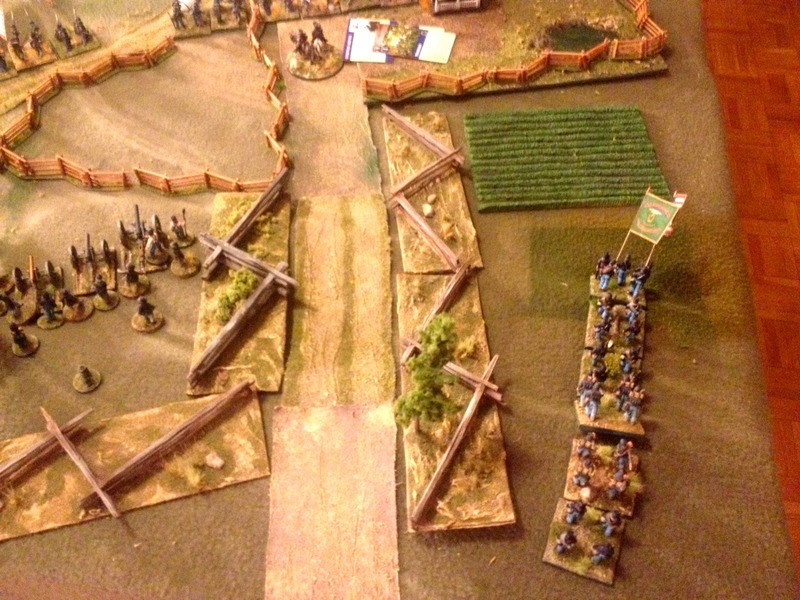
The Pabst Blue Rifles move up the hill and into the woods with the intention of charging Snedden’s battery. Normally in Longstreet woods are not obstructing or disrupting to infantry. However, the CS play a card that makes it disrupting to enter the woods this turn, forcing the Yanks to burn an extra card to do so.
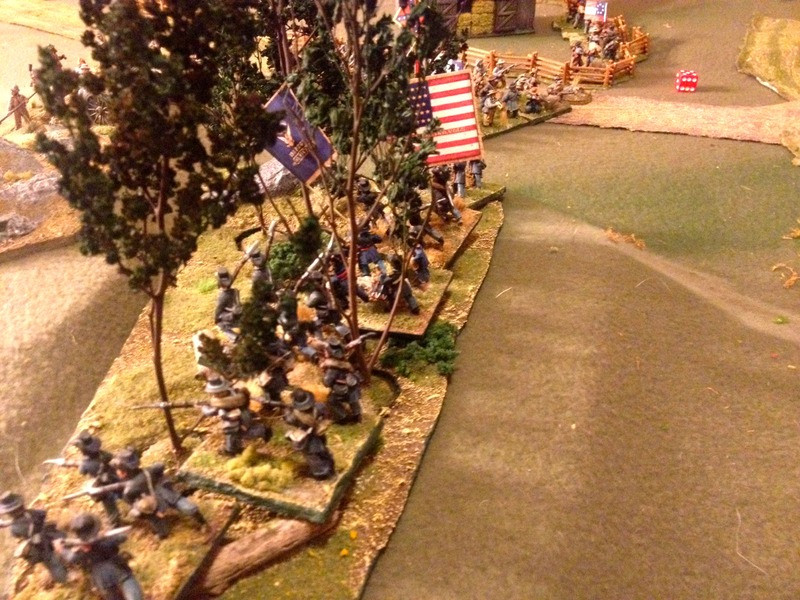
Bird’s eye view of the situation at the end of the Union turn.

Confederates begin their next turn by playing a card to declare a fire phase. Snedden’s battery can’t shoot at the Pabst Blue Rifles because there’s more than 2BWs of forest separating them, so the guns join with the 21st MS in bombarding the Schlitz Jaegers in the US centre. With three artillery stands bombarding, and three infantry bases firing, the rebs do well and score four hits on the German boys.

Here’s an example of how Longstreet’s Morale or casualty mitigation rules work. Before the CS player rolls to see how many of the four hits are actually kills, the US player can use cards to reduce the number of hits. Since the Schlitz Jaegers are a Recruit regiment, only one card can be played. The US player has the Old Rivals card, which can be used as an Interrupt card to do bad things to the CS in his turn. However, it can also be used as a morale card, in which case the number on the top left is the number of hits that are removed. This halves the number of hits that might cause kills on the Schlitz Jaegers.
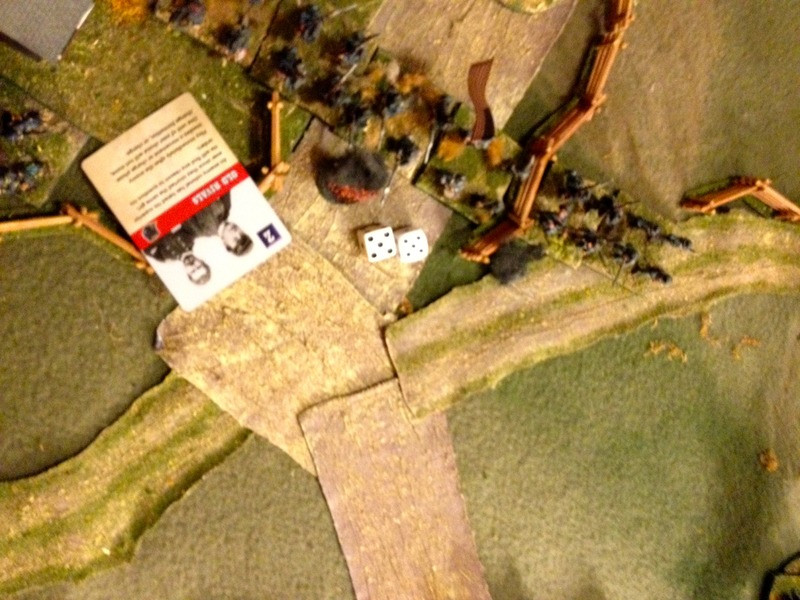
Alas, this time the Schlitz Jaegers are not so lucky. One of the hits is rolled as a kill. “Aaahhhhhh!!!!! I thought this war would be fun!”. The Jaegers lose a stand. Casualties are now matched.
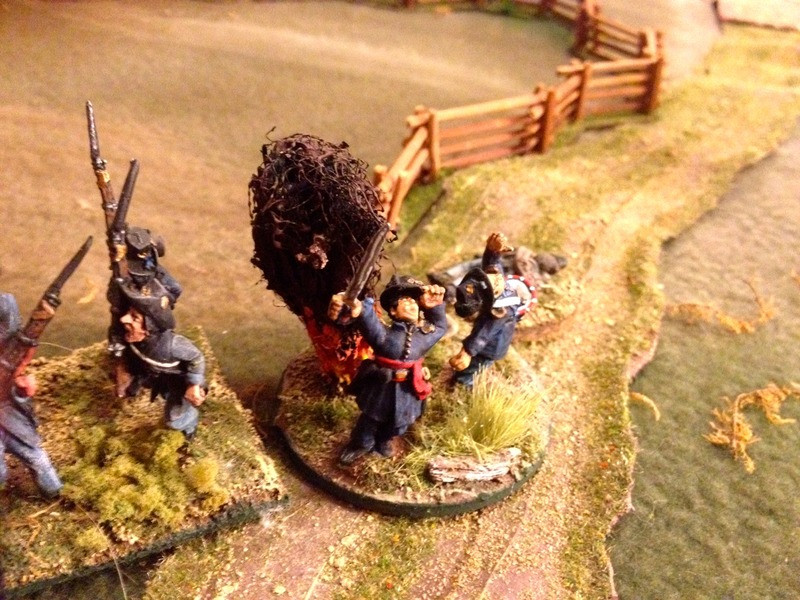
CS movement phase. Behind the embattled 21st MS, the 5th KY (“The Lincoln Killers”) right wheel into a position on the flank of the Pabst Blue Rifles. Are they going to charge next turn? Oh yeah.
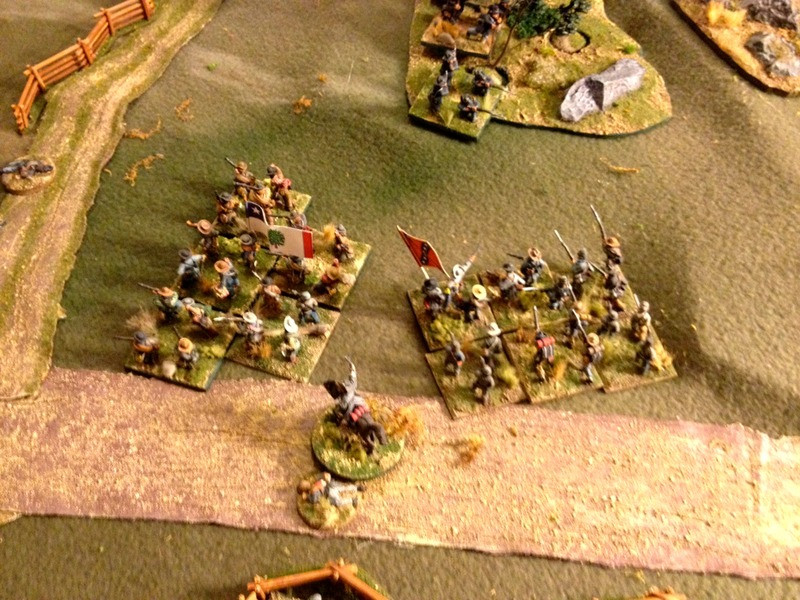
Also part of this CS movement phase, the 4th TX, which was wrongly headed out of the battle and into the woods to its right, extricates itself by forming line and turning about face to threaten the Yanks up on that hill.

Another example of sneaky card play in Longstreet. At the start of the US turn, the CS plays this as an Interrupt card, which takes two a random number (1d6) of cards out of the current US hand. Not a terrible result, but still annoying if the US wants to achieve a lot this turn. Since I was playing solitaire, I chose the cards to be discarded randomly. Since it is used as an interrupt card, it is out of the CS deck for the rest of the game.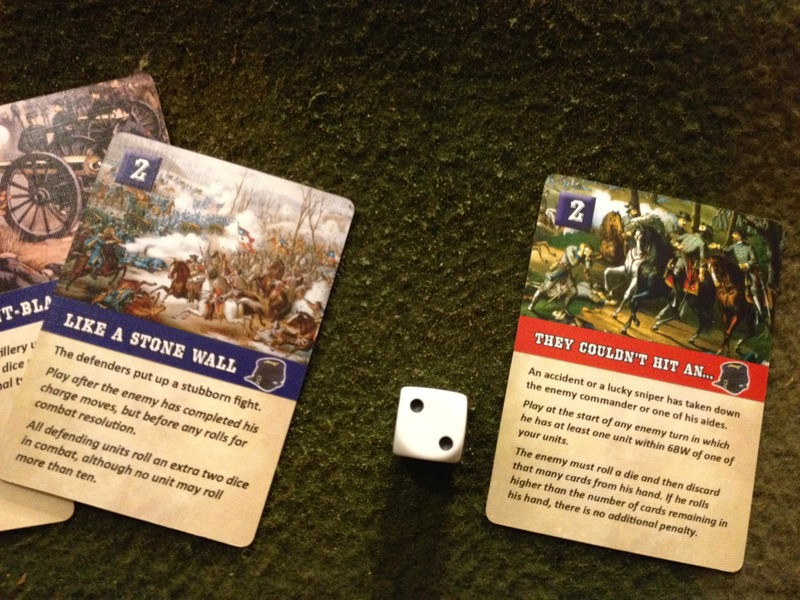
US spends a card to start the turn with a Fire Phase. Engel’s battery finally gets to fire for their guns in anger for the first time. “Prosit!” they yell humorously as they let fly at the rebs.
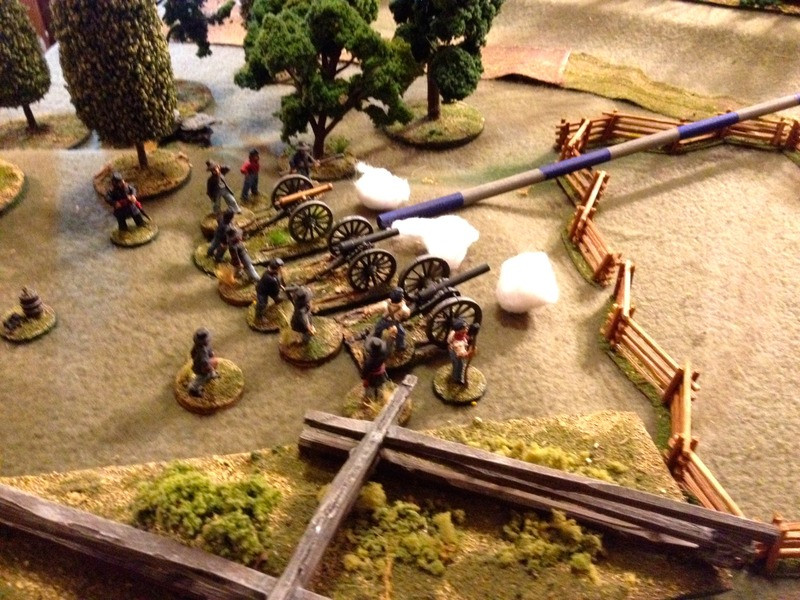
Engel’s target (at the end of that handsomely painted range stick) is the 5th Kentucky, which has moved into position to flank the Pabst Blue Rifles in the woods.
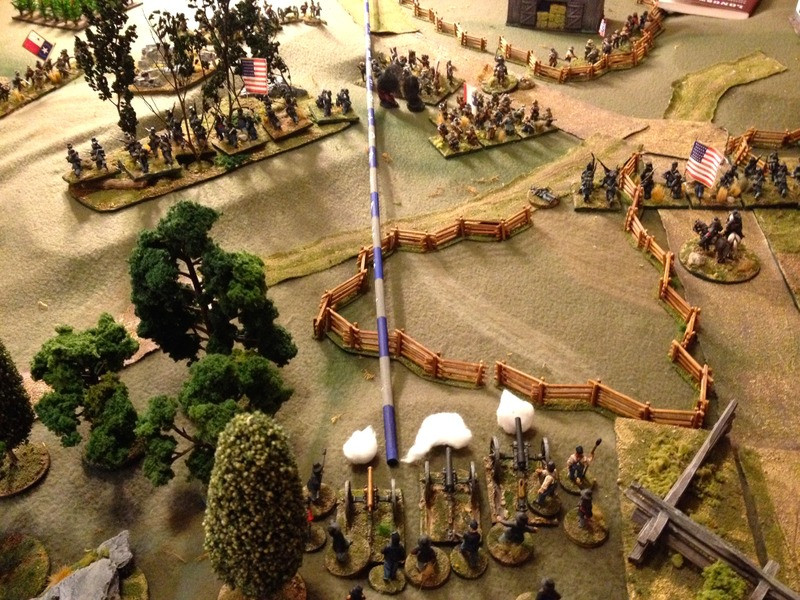
While in the same US fire phase the Schlitz Jaegers fire four stands at the left oblique at the 21st MS.
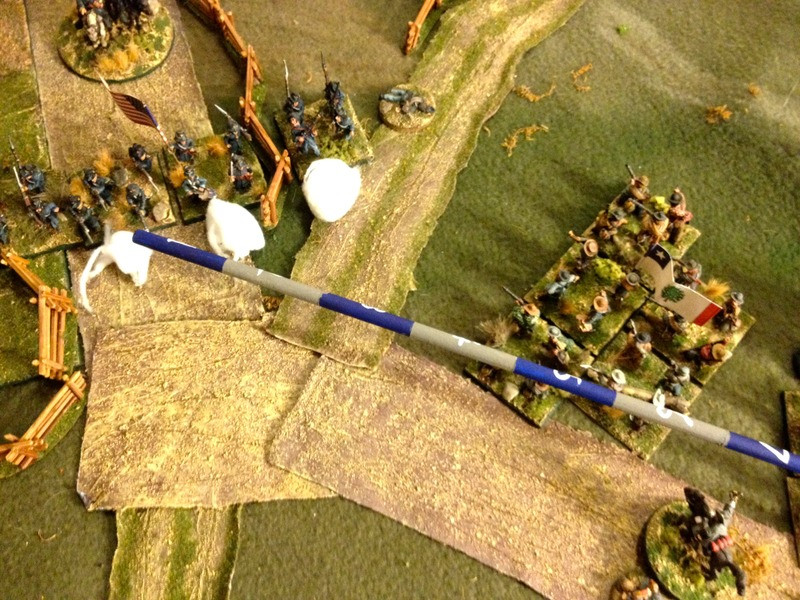
US gets two hits each on the 21st MS and the 5th KY. CS mitigates the damage by playing two cards to reduce the hits by one per unit. One hit will always remain - one of Longstreet’s core rules is that no matter how many morale cards you play to mitigate hits, “One Hit Always Sticks”. Then the US roles for kills and misses both rolls, including the reroll on the fire of the Schlitz Jaegers thanks to Col. Schotz’s special ability to influence the musketry of one infantry unit per turn. “Nein, dumpkoffs! You are shooting too high! Shoot at zee belly buttons like I am telling you in practise!"
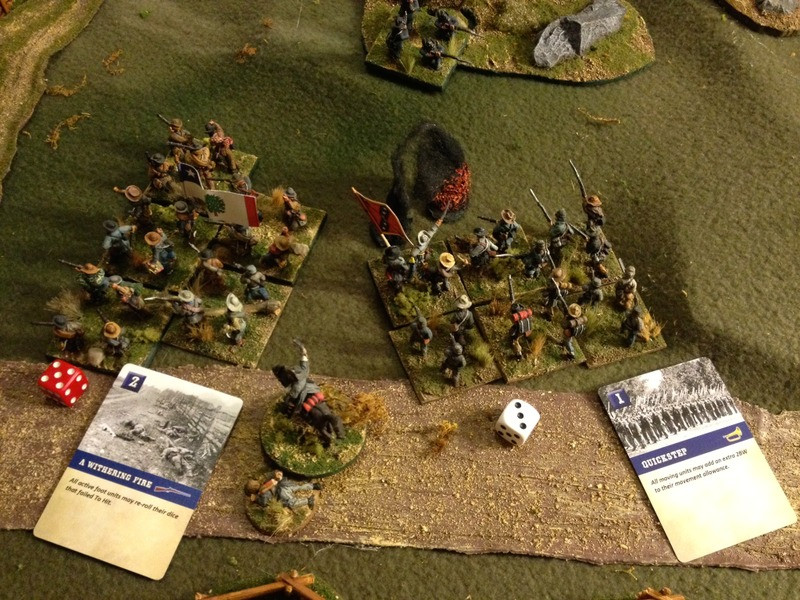
That was disappointing. The Pabst Blue Rfles up on the hill are now in an untenable situation. They can’t reach Snedden’s battery in a charge move, it’s about a BW too far away, so they would just end up standing in canister range. They can’t remain there with the Kentucky boys on their flank. The PBRs spend two cards to make an about turn (two cards because an About Turn within 6BWs of an enemy is a Disordering Move) and march their full move of 4BWs. They can’t About Turn twice in a turn so they finish the move with their backs to the enemy. Hopefully the 5th KY can’t reach them in a charge move - they might if the right card is in the CS hand, so this is a calculated risk.
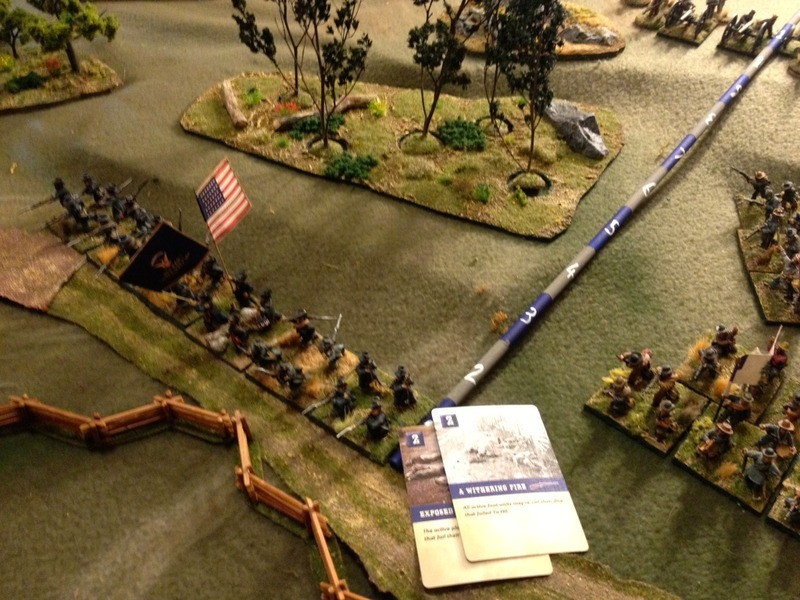
For the rest of the US movement phase, the dismounted Kansas cavalry push forward to threaten the their opposite numbers, while McCleary’s Irish continue to advance in column. Schotz is hoping that if he can throw enough weight on his right flank he can relieve the pressure on the rest of his line. That column will have to veer left or right to avoid that duckpond!
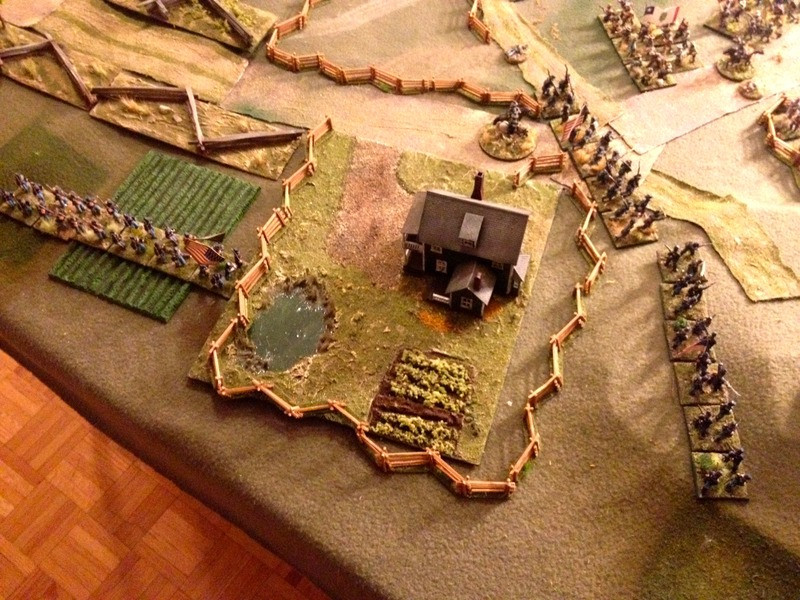
Play is interrupted by a kitten on the table. Sadly that’s not a Longstreet Interrupt card (which would be awesome), but there are DIY cards in the deck so I could design one, I suppose. This is Luigi. He’s three months old and we just adopted him from the local shelter because we didn’t have enough cats or something, I don’t know. He’s quite charming and fearless, and a dauntless explorer. I am hoping that come my posting this spring, our new house with have a room with a door for my next games room.
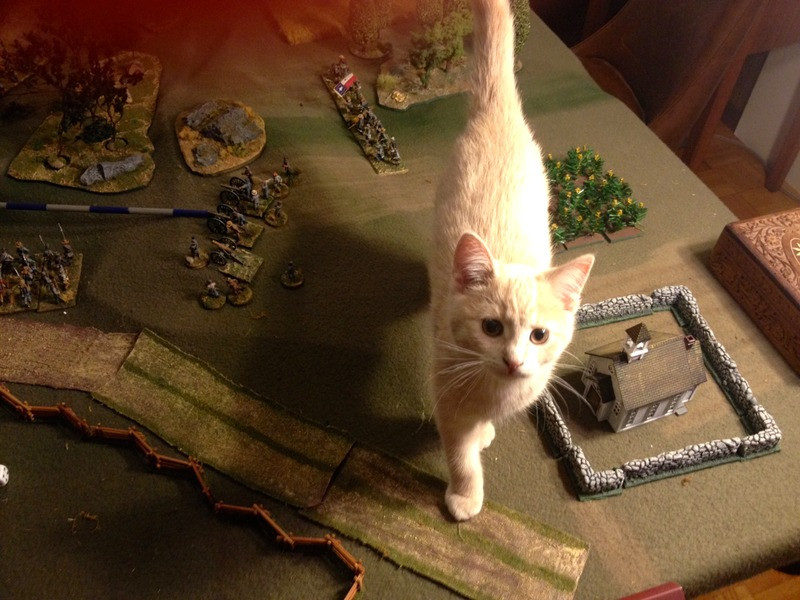
Hopefully one more post will tell the outcome of this riveting action.
Blessings to your die rolls!
MP

Every wargame room should have a cat really.
ReplyDeleteBut back to the game, I've found that with most (or all) of these new fangled card driven systems that one has to play a couple of games before you see past all the gimmicks to appreciate the under lying battle and can see how the cards affect rather than replace tactics.
Nice series of posts.
Thanks Ross. He is a very charming cat to whom much is forgiven for now. For a while I was experimenting with using old blankets and quilts under the surface cloth I use to represent hills and elevations and I noticed that our older cats were suddenly taken with the urge to sleep on the games table. I normally leave a battle out for a week or two at a time, so they had lots of opportunities to camp there while I was absent.
DeleteIt would be hard to think of a contemporary set of rules that isn't card rive. OK, I don't think any of the mainstream rules - various GW Warhammer rules, Bolt Action, Flames of War, use cards, but certain publishers seem to like them - a lot: Piquet, Sam Mustafa, Too Fat Lardies ... Years before specialized rules came into vogue, conventional playing cards were often used as randomizers. I suppose the elite grognard might think it was too "gamey" and "childish" to play a "Confusion" card and deliberately misdirect a key unit. In a game like Longstreet, you could order a defending unit holding a ket set of works to advance out of them. What does that legitimately simulate? Is it perhaps the equivalent of casting a spell or hex on your opponent, or does it simulate a commander misinterpreting rules, having a bad/drunk/senile moment, etc? I think in a game like Longstreet part of the attraction is stuffing your opponent by playing a clever card on him at a bad moment, whig appeals to our baser nature. However, under that system may lurk, as you say, a sound mechanic. For example, the more cards you play in Longstreet the more you have to reshuffle the deck, and each reshuffle you take out six cards that are no longer available that game, so the deck dwindles, and when you are out of cards before your opponent you lose. Does that reflect battlefield fatigue or coherence reaching a critical mass where the army just packs it in? Perahps.
One of the things I eventually noticed when we first started playing Memoir and Battlecry was that if you based your battle plan on the cards in your hand then you were likely to lose. The next thing I noticed was that if you ignored the cards in your hand when you were making and executing a plan you were also more likely to lose. Since then the best bet has been to come up with a solid plan that meets solid non game military principles and then modify the details of execution based on what the cards make possible.
DeleteCat is adorable, though I count my self lucky owning a cat with a bad hip who cant jump on my gaming table or hobby surfaces. :)
ReplyDeleteAwwww, poor kitty. Mind you, I've already had a near disaster with cat jumping on my painting desk, so I could see the advantage of a bad hip.
DeleteGreat read again! Can't wait to see the outcome.
ReplyDeleteThank you Martin. So am I. Still anyone's battle.
DeleteEnjoying this narrative, Michael...
ReplyDeleteCheers Ion. Thanks.
DeleteLuigi either wants to advise you on tactics or remind you to pay attention to him instead.
ReplyDeleteHe's very young so I don't think he has much experience. I think his advice was to "bat them and knock them over". Not sure how discriminating "them" is. He does think that model trees are good to nibble on.
DeleteEnjoyable BatRep, Michael, and a good intro into a system I know nothing about. Awaiting the final installment.
ReplyDeleteThanks Jonathan. That's sort of my goal here, to give a rolling explanation and critique of the rules as I learn by doing. So far I think I like them
DeleteGreat looking game. I'm a Fire and Fury ACW player, but Longstreet looks interesting.
ReplyDeleteHi Mark:
DeleteI rather feel that I should check out RF&F when I am done with this game of Longstreet, as my gut feeling is that it may be a little more detailed and serious. I should get myself invited to an RF&F game, not sure after shelling out for Longstreet that I need to buy another set of ACW rules.
RF&F is loads of fun and surprisingly (In my humble opinion) not at all a complex set of rules.
DeleteI've looked up the Prof Mustafa games, and have joined the 'Honour;' group. Mainly for the discussions and game philiosophy, though I might (if I can afford it) look into buying the 'Blucher' set. That apparently is not card driven. In one of his Podcasts, Prof Mustafa allowed that he did publish 'Lite' versions of his games, such as 'Longstreet,' that didn't use the cards. He did reckon that with was more fun than without, though...
ReplyDeleteI used the Lite version to decide whether to get but SM's 18th century rules set, "Maurice". I had several quite satisfactory battles just using the free download version of the rules. I thought that was rather a gutsy and customer friendly move on his part. The Honour website does seem to have a lively forum community, which helps. I've answered several rules questions by looking at the Longstreet forum.
Delete